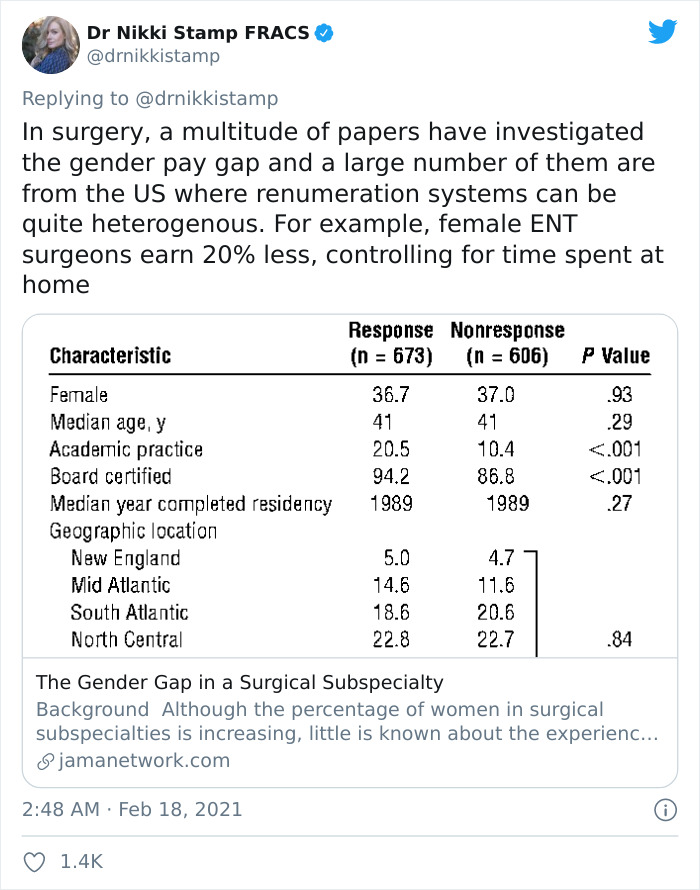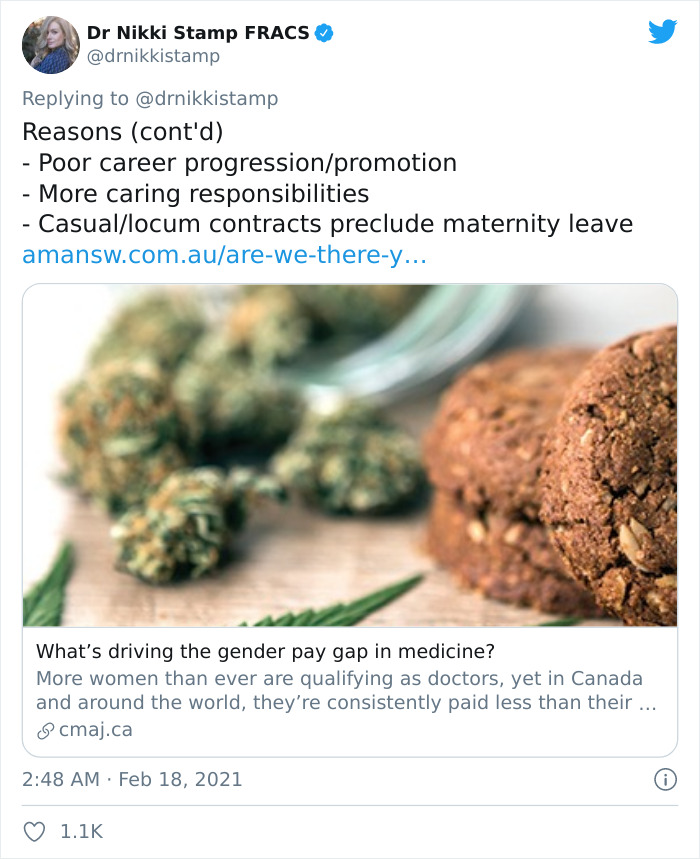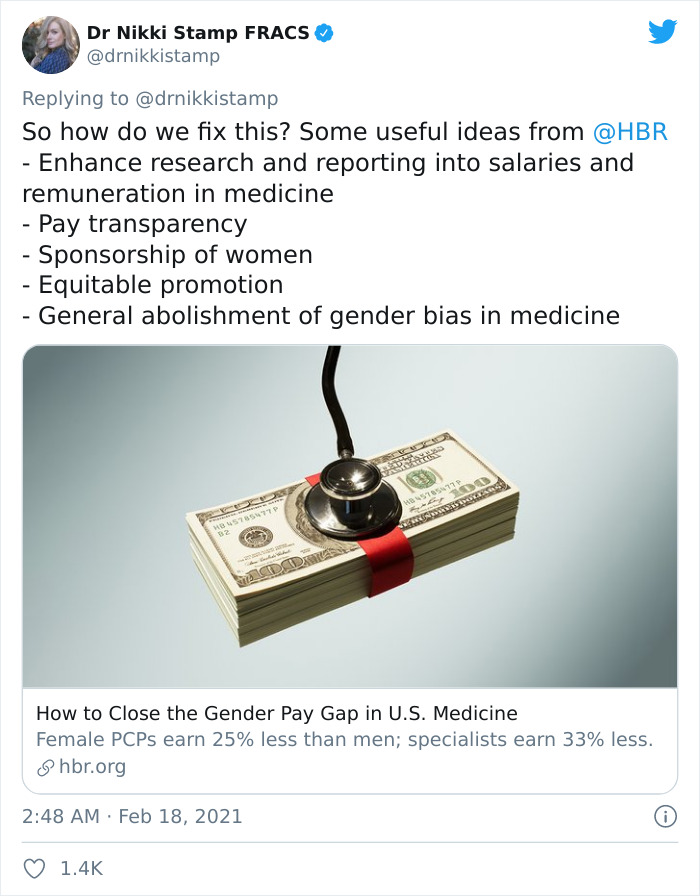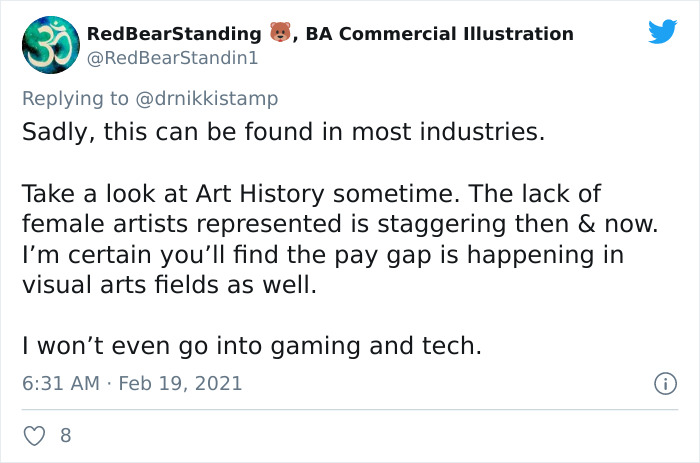The wage gap between men and women is very real, even in our oh-so-modern Western society. However, not everyone believes it is. And some think that it doesn’t exist in prestigious areas like medicine.
Well, Dr. Nikki Stamp, a heart and lung transplant surgeon from Australia, put them right in a viral Twitter thread. She did what all good scientists do: she followed the evidence. Have a read through her arguments below and let us know what you think.
According to Dr. Stamp, the wage gap is deeply enrooted in the entire job industry: it’s even prevalent in very prestigious parts of the job market. And if inequality exists there, well, imagine how visible it is in other areas, too.
More info: Twitter | DrNikkiStamp.com

Image credits: jeshoots
Dr. Stamp provided a bucketload of evidence as to why the gender pay gap exists in medicine and what can be done about it

Image credits: drnikkistamp

Image credits: drnikkistamp

Image credits: drnikkistamp

Image credits: drnikkistamp
The Gender Gap in a Surgical Subspecialty

Image credits: drnikkistamp
Pay gaps in medicine and the impact of COVID-19 on doctors’ careers

Image credits: drnikkistamp
Sex-Based Disparities in the Hourly Earnings of Surgeons

Image credits: drnikkistamp

Image credits: drnikkistamp
A Structured Compensation Plan Improves But Does Not Erase the Sex Pay Gap in Surgery

Image credits: drnikkistamp
Wages and Women in Health Care: The Race and Gender Gap

Image credits: drnikkistamp

Image credits: drnikkistamp
What’s driving the gender pay gap in medicine?

Image credits: drnikkistamp
Gender pay gap growing

Image credits: drnikkistamp
How to Close the Gender Pay Gap in U.S. Medicine

Image credits: drnikkistamp

Image credits: drnikkistamp

Image credits: drnikkistamp

Image credits: drnikkistamp
Dr. Stamp explained that some of the ways that could help fix the income inequality in medicine could be to have better pay transparency, sponsor women, and promote employees equally.
She also said that generally abolishing gender bias in medicine is something that we should strive towards (though that’s unlikely to happen overnight even with the best of intentions). What’s more, better research and reporting of salaries in medical fields could help with transparency issues. In other words, if you know what your colleague is getting paid, you’ll start asking questions why you’re not for the same work that you do.
The Harvard Business Review suggested that the pandemic reversed a lot of the progress toward greater gender equality that had been achieved over the past few years. According to them, women’s jobs are a whopping 1.8 times more vulnerable during the Covid-19 pandemic than men’s are.
“Women make up 39% of global employment but account for 54% of overall job losses as of May 2020,” HBR writes.
What’s more, Forbes explains that women take on the vast majority of extra chores, childcare, and education for their families at home. In short, there’s a disproportionate division of labor at home between partners.
Here’s how people reacted to Dr. Stamp’s viral Twitter thread and insights

Image credits: akuhabaki

Image credits: Silfy_Star

Image credits: justinerogers

Image credits: w1lko21

Image credits: SallyMayweather

Image credits: chelsairitops

Image credits: RedBearStandin1

Image credits: jennie0501
In an earlier interview, we spoke with Eddy Ng, the James and Elizabeth Freeman Professor of Management at Bucknell University, about how the pandemic has unequally affected women in the workforce and why.
Professor Ng explained that women are “overrepresented in lower-paying and precarious jobs.” Areas like retail, service, and hospitality have far less job security and benefits. “Men on the other hand are found in industries that are deemed essential, such as transportation (delivery) and construction,” he said.
The Covid-19 pandemic, as well as the massive restrictions on businesses and movement, forced many retail and hospitality businesses to scale down. Others went bankrupt. This meant that a large number of women were laid off from their jobs or displaced. According to Professor Ng, the situation is even worse for women of racialized backgrounds.
Unfortunately, the coronavirus lockdowns didn’t lead to greater gender equality that some people expected to see.
“Women, even those in professional and managerial jobs, continue to take on a second shift (caring for family) after the first shift at the office. We continue to subscribe to gender roles, even in many egalitarian societies,” he said, adding that this is one of the reasons for the “persistent pay gap and an underrepresentation of women in senior management and higher-paying jobs.”
He added that men’s higher-paying careers are prioritized over women’s (seen as “supplemental income”) during lockdowns. “Women reorganize their work around family demands, men often do not. Unequal division of labor is exacerbated when a family could no longer access paid help (COVID restrictions), and women will have to pick up the slack.”
Why do you think the wage gap between men and women exists, dear Pandas? Were you surprised that the medical field isn’t immune to the gender wage gap? What do you think could be done to realistically reduce income inequality in medicine in other areas? Were you ever a victim of sexism at the workplace when it came to your wage? We’d love to hear your thoughts on everything.
The post Male Colleagues Tell A Female Heart Surgeon That The “Gender Pay Gap” Is Not Real, She Exposes The Reality first appeared on Bored Panda.
from Bored Panda https://ift.tt/3aGExYw
via IFTTT source site : boredpanda